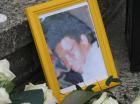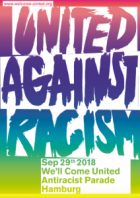Analysis: The dynamics of inter-communal violence in Mali
IRIN (a service of the UN Office for the Coordination of Humanitarian Affairs), 31 January 2013
Ethnic Tuaregs and Arabs in towns across central and northern Mali, including Gao and Timbuktu, have been fleeing into the desert or to neighbouring countries as their houses and shops are looted or they are hunted down on suspicion of being Islamist militants. Fears of inter-communal violence are spreading. Shops and houses owned by Tuaregs, Arabs or Mauritanians in Timbuktu have been looted since 28 January, according to local reports.
Moulaye Cherif Haïdara, a Malian journalist with national media bureau ORTM, told IRIN from Timbuktu: “Almost all of the Arabs have fled Timbuktu, fearing reprisal attacks. Many here believe Arabs were complicit with the Islamist groups who terrorized populations over recent months.”
Two Malians of Arab origin were badly beaten up on the outskirts of Timbuktu when attempting to flee, he said. Malian military leaders are trying to control the situation. Col Keba Sangaré, who is heading Malian operations in Timbuktu, gathered residents in the market-place: “Not all Arabs are rebels. Be careful. Do not take all Arabs and Tuaregs to be associated with jihadist groups. Be tolerant and patient and let the army and the authorities deal with this problem.”
In Gao most of the shops run by Arabs have been shut. Three men found hiding under a tarpaulin in the market-place were reportedly beaten up and left for dead. The mayor, upon returning to town, appealed for peace, telling a reporter from Le Monde: “I am a Peulh, but I cannot live without the Arabs or Tuaregs.” Local radio station Radio Koima is also trying to appeal for reason, reportedly warning people to report any suspected Islamists to the authorities, and not to take the law into their own hands.
Even in the capital, Bamako, Tuaregs and Arabs are starting to feel insecure, individuals told IRIN. Assaedek Mohamed, a Tuareg, says he is scared to leave the house. “Believe me, it is not nice to leave your home in Bamako and have everyone look at you strangely… to have people mutter “rebel” as you walk down the street, and to have your fellow citizens tell you the best way to finish off this cycle of rebellion is to get rid of Tuaregs altogether.”
Reprisal killings
The latest ethnic violence comes on the back of reports from the International Federation for Human Rights (FIDH) that Malian armed forces carried out reprisal killings against Tuaregs and ethnic Arabs, allegedly feared to be rebel “infiltrators”, in Sévaré, Mopti and Niono in central Mali.
Some reports suggest bodies were dumped in shallow graves or in wells. Human rights groups, including Human Rights Watch and Amnesty International, are further investigating reports of abuses across the country and will report their findings imminently; FIDH has called for an independent inquiry and has supported the International Criminal Court’s 28th statement implying it will look at abuses carried out by all sides in Mali since the beginning of 2012.
In Sévaré, citizens spoke to IRIN of hastily buried bodies. Many associated being an Arab or Tuareg with being a rebel. In Douentza to the north, truck-driver Mohamed Diarra told IRIN he saw men in army uniform quickly digging shallow graves with at least three bodies lined up.
The Malian army has been linked with violent crackdowns against Tuareg rebel uprisings in the past, which has led to tension between Tuaregs and the army, despite efforts to incorporate Tuaregs into the armed forces.
Chief of Staff of the Malian Army Gen Ibrahim Dahirou Dembélé told IRIN his forces would be held to account: “Any Malian soldier that commits atrocities against civilians will be immediately brought from the field and judged by a military tribunal. The army must be without reproach and there can be no question for us that we are sanctioning acts that we blame terrorists for,” he said.
He added it was important not to assume that all of the yet-to-be-confirmed atrocities were connected to the Malian army. “There are men who wear Malian military uniforms to commit abuses while pretending to be members of the army,” he said, explaining that the army has arrested 50 or so criminals masquerading as soldiers in Sévaré, Diabaly, Douentza and Bamako.
French Prime Minister Jean-Marc Ayrault called on 27 January for the quick deployment of international monitors to Mali, to try to minimize further violence.
Will militias groups get involved?
An important factor dictating whether or not inter-communal violence will get out of control, is whether or not the many militia groups, which have been trained and “intensively indoctrinated” over recent months, get involved, said Yvan Guichaoua, Sahel expert and lecturer in international development at the University of East Anglia.
The Ganda Koy militia, with several hundred members, is the largest of many homegrown armed civilian groups, many of them set up in response to Tuareg rebellions of past decades. Djibril Diallo, head of Ganda Koy, told a reporter: “We consider all Tuaregs MNLA [National Movement for the Liberation of Azawad].”
Arabs and Tuaregs are considered to be complicit with Islamist rebel groups Al Qaeda in the Maghreb (AQIM), Movement for Oneness and Jihad (MUJAO), and Ansar Dine, despite the fact that these groups promptly ousted the secular MNLA from northern Mali in April 2012.
During that time, citizens of the north accused the MNLA, and the Islamist groups who followed, of carrying out widespread looting, sexual violence and other abuses, as evidenced by human rights groups.
Context
The highly complex and ever-shifting network of alliances and rivalries among Tuareg nationalist groups; Islamist groups run by Malians, Algerians, Mauritanians and others; and numerous militia groups in the north and south, has created years of ethnic tension and inter-communal violence in Mali, which sits alongside a cultural context of inter-ethnic tolerance.
The Islamist groups running northern Mali were by no means only Malian: AQIM originated in Algeria (originally the Salafist Group for Preaching and Combat) and had many non-Malian members; MUJAO was headed by a Mauritanian and an Algerian, and recruited many non-Tuareg youths into its ranks.
Ansar-Dine, which until it split into two recently, was led by Iyad Ag Ghali, a prominent figure in the 1994 Tuareg rebellion and allegedly a key negotiator in myriad hostage deals between AQIM and Western governments, many of which allegedly benefited leaders in the Malian administration, including ex-President Amadou Toumani Touré (ATT).
The dynamics between these groups further complicated long-standing alliances that had been formed, opening up space for more instability. For instance, when the MNLA vied for control of Timbuktu in April 2012, it was soon crowded out by local Arab militias previously allied with the Malian state in Bamako, but which “dramatically shifted their loyalties” to ally with Ansar Dine and AQIM, said Guichaoua, the Sahel expert at the University of East Anglia.
MUJAO, an AQIM splinter group, took control of parts of Gao by allegedly making a deal with youth militias, Arab traders and drug traffickers to oust the MNLA.
Before these events, inter-ethnic relations in northern Mali were already at a very low point, said Guichaoua, characterized by an intensification of micro-conflicts: between farmers and pastoralists; over drug trafficking; over deals on electoral mandates, AQIM’s entrenchment, and personal politics.
Tensions between prominent Tuareg groups and members of AQIM were high following a decade during which AQIM had fully entrenched itself in northern Mali, with members circulating widely across the territory. Complaints by Tuareg groups of what they saw as intrusion were not picked up by the authorities in Bamako. Local youths, meanwhile, benefited from paid jobs as AQIM members.
If Arabs and Tuaregs return to their northern homes, more mundane rivalries could also exacerbate tensions between those who stayed in the north and those who fled, said Guichaoua, such as conflict over land, property or livestock abandoned by some who fled, and seized by others.
“These ongoing low-level conflicts could be exacerbated now. It happens in all wars where some had to flee and others had no choice or for various reasons decided to stay,” he said, citing a similar dynamic in Côte d’Ivoire’s crises over the past decade.
Now that the political situation is changing – and quickly – “all of the people who feel they have been betrayed, want to right wrongs,” he added.
In the medium term, the French are likely to rely on Malian, and Chadian and Nigerien forces to secure the north. Troops from Nigeria, Burkina Faso, Senegal and Benin are also arriving, and the overall size of the West African intervention force in Mali is expected to reach 6,000.
In the longer term, only initiating an inclusive south-north peace process that realistically addresses the repeated demands made by northern groups – development dividends, and some degree of self-rule – can sustainable peace be built, say analysts.
On 30 January, French Foreign Ministry spokesperson Philippe Lalliot called for a peace process with legitimate representatives from the north, including non-terrorist armed groups. Charles Grémont, historian at the Research Institute for Development in Marseille, told IRIN: “The most important thing is for the representatives of the local population to talk to each and not just leave the affairs to armed groups. Local leaders … must play their role and talk sincerely amongst themselves, while [the administration in] Bamako and the international community should listen to them.”
Rebuilding the ailing Malian army and finding solutions to the political disarray in Bamako are also vital. Mali’s parliament announced a political roadmap on 29 January to pave the way for 31 July elections.
Tuaregs who spoke to IRIN said they are tired of only being seen as part of the problem, not part of the solution. “We [Tuaregs] can help fight Islamists. We are part of the solution,” said Mohammed Ag Ossade, director of the Tuareg cultural centre in Bamako.
Most of Mali's 15 million people are from the Mande, Peulh and Songhai ethnicities and make up 90 percent of the population, outnumbering the 10 percent that are lighter-skinned Tuaregs and Moors, mostly inhabiting the desert north.
aj/sd/kh/cb



